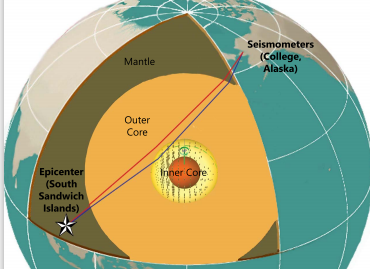According to a paper published this week, the Earth is cooling quicker than previously anticipated, which might have severe consequences for life on the planet.
However, given the vast time scale on which Earth exists, any changes brought about by the cooling will take millions of years or more to influence life as we know it.

The article "Radiative thermal conductivity of single-crystal bridgmanite at the core-mantle boundary with implications for Earth's thermal evolution" claims that mantle convection is far more powerful than predicted, as well as faster mantle cooling.
Layers
The planet is made up of numerous layers, one of which is the mantle. According to the USGS, the crust, mantle, and core are the three primary layers of the Earth. "This layered structure can be compared to that of a cooked egg," the USGS notes.
The crust is hard and very thin compared to the other two layers. The crust underneath the seas is relatively thin, reaching just around 5 kilometers. Like the shell of an egg, the Earth's crust is fragile and susceptible to breaking.
"Below the crust is the mantle, a dense, hot layer of semi-solid rock about 2,900 kilometers thick," the USGS continues.
What's Happening Inside the Earth
Because temperature and pressure inside the Earth increase with depth, the mantle, which contains more iron, magnesium, and calcium than the crust, is hotter and denser. The mantle can be compared to the white of a boiled egg.
Continuing the egg analogy, the USGS says the core is the center of the Earth and is similar to the yolk of an egg. Unlike the yolk of an egg, the Earth's core is made up of two different parts: a 2,200 km-thick liquid outer core and a 1,250 km-thick solid inner core, according to the USGS.
The Earth's interior is critical for life on the surface. The liquid outer core spinning creates the Earth's magnetic field as the Earth rotates. Life would be substantially different if the Earth's magnetic field altered.
Geomagnetic Field
According to NASA, nearly most of Earth's geomagnetic field originates in the fluid outer core. "Convective forces that carry heat from one point to another, generally through air or water, continually churn the molten metals, which also swirl in whirlpools powered by Earth's rotation," NASA adds. As the Earth spins, this churning mass of metal creates electrical currents that are hundreds of miles broad and run at thousands of miles per hour. The geodynamo is the mechanism that keeps the Earth's magnetic field in place."
The magnetic field generates two poles, commonly known as a dipole, at the Earth's surface. The north and south magnetic poles have opposing positive and negative polarities like a bar magnet. The magnetic field's invisible lines flow into Earth at the north and out at the south in a tight, continuous loop.
The Earth's magnetic field shields the globe from dangerous solar radiation and space weather, in addition to assisting a compass in determining the direction it is pointed in.
The magnetosphere shields Earth's atmosphere from solar winds, erosion, and particle radiation from coronal mass ejections (CMEs), as well as cosmic rays from outer space. Radiation would substantially modify, if not eliminate, life on Earth if it did not exist. If solar winds reached Earth unimpeded, electronics, satellites, and most contemporary comforts would be destroyed.
The authors of a new study published this week looked at bridgmanite, a typical conductive mineral found between the Earth's core and mantle. They discovered it to be 1.5 times more conductive than previously anticipated, implying that Earth's cooling process may be faster than previously assumed.
"We discovered that the bulk thermal conductivity at the core-mantle barrier is 1.5 times greater than the widely believed value," the researchers explained. "This enables stronger heat transfer from the core, and hence more robust mantle convection than predicted."
Internal Temperature

"The findings show that the mantle is more effectively cooled, which would diminish numerous tectonic events powered by mantle convection more quickly than traditionally assumed thermal conduction behavior would predict."
The magnetic field may vanish if the Earth's core or mantle cooled to the point of solidification, putting an end to life. Scientists are confident that this will occur since it has already occurred in our solar system, with Mars serving as an excellent example.
The smoking gun of what happened to Mars was just discovered by NASA's Mars Atmospheric and Volatile Evolution (MAVEN) mission: it used to be considerably warmer. It had a thicker, more Earth-like atmosphere.
According to a NASA study, the bulk of the Martian atmosphere was destroyed by the intense solar wind owing to a lack of magnetic field shielding, leaving a desolate, red planet in its wake. When the Earth's magnetic field fails, scientists believe the same thing will happen to the atmosphere.
However, there's no need to panic just yet. While the authors of the research did not provide a time frame for when the Earth's interior cooling would result in the loss of the magnetic field, most scientists believe that such an event would occur millions, if not billions, of years in the future.
Read also: Long Valley Supervolcano: World's Most Dangerous Volcano Shows Signs of 'Imminent Eruption'
For similar news, don't forget to follow Nature World News!
© 2025 NatureWorldNews.com All rights reserved. Do not reproduce without permission.





